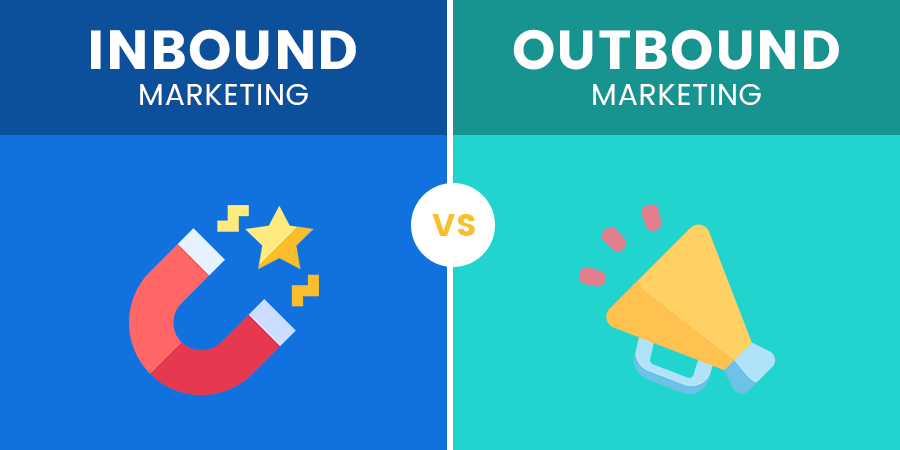Marketing is all about the process of exploring, creating, and delivering value to meet the needs of the target market in terms of goods and services. There are two types of marketing in this digital world, i.e., Inbound Marketing vs Outbound Marketing. Both are different ways of marketing to enhance the reach of products and services of a business.
However, there is a never-ending battle in the sales world, which is inbound vs. outbound marketing. Many entrepreneurs are wondering which one is the best for their business. And mainly, what is the critical difference between these two? Which one will be the right approach for their business?
about inbound, people choose Inbound marketing based on their preferences because inbound enables brands to attract customers, is pocket-friendly, and scales extremely well. However, outbound marketing is one of the most robust ways to build trust, maintain control, and close big deals.
The fundamental truth is that both approaches have their pros and cons, and they should be viewed as tools to yield to accomplish goals and results. Both the marketing methodology is based on the strategy you design for your team. It depends on the type of sales strategy you use, your goals, your target audience, and other variables depending on the specific situation.
To give you clear insight into both the marketing strategies, we did detailed research on every aspect that will help you know more about inbound and outbound marketing. First, let’s start with an overview of inbound and outbound marketing.
Inbound vs Outbound Marketing Meaning
An Overview of Inbound Marketing
Inbound marketing is the process of helping potential customers find your product and services. This frequently happens before the customer is ready to purchase, but making early contact can turn into a brand preference and, ultimately, leads and revenue. Basically, an inbound methodology is a strategy that utilizes many forms of pull marketing such as content marketing, blogs, events, SEO (Search Engine Optimization), Social media, and more to build brand awareness and attract new customers.
Inbound marketing has the power to put your customers in the driver’s seat, connecting with the audience who are genuinely interested in what you have to say. Powerful inbound marketing enables customers to engage with your brand anytime. This allows you to generate qualified leads for much less money than traditional marketing strategies.
People like inbound marketing because it gives you the power to give searchers/consumers precisely what answers they are looking for at the precise point they need. It helps you build trust, reputation, and authority in whatever niche you practice.
The Inbound methodology can apply in three ways:
- Attract:
This methodology means, drawing in the right people with the valuable content and conversations that establish you as a trusted advisor. - Engage:
Engage means presenting solutions and insights that align pain points and goals so your customers can purchase from you. - Delight:
Providing support and help to your customers to find success with their purchases.
An Overview of Outbound Marketing
Outbound marketing strategies consist of various marketing strategies and techniques that simultaneously target a large number of people. Outbound marketing strategies are the polar opposite of inbound marketing, where your prospects find you to get solutions to their problems.
Outbound marketing is often associated with traditional marketing, like direct mail, cold calling, billboards, events, newspapers, and radio. However, outbound marketing can also be applied to more modern technology like PPC (pay-per-click) advertising and spam emails.
Types of Outbound Marketing Channels
- Traditional Advertising
Traditional advertising includes radio, television, print (magazines, newspapers, etc.), and billboards. - Through-the-line (TTL) Advertising
through-the-line advertising includes DOOH (digital-out-of-home) advertising; it is an emerging advertising format that uses traditional outdoor media to display dynamic ads. - Cold Calling
In cold calling, a salesperson calls people who could be prospects to grab their interest and convert them into paying customers. - Cold Emails
In cold emails, you send mail to your target audience to let them know about your product and services. - Content Syndication
In content syndication, you publish your content on a third-party website. It could be a guest post, interview, or thought leadership piece.
Difference Between Inbound and Outbound Marketing
| Inbound Marketing | Outbound Marketing |
|---|---|
| In inbound marketing, the informative digital content targeted at specific audiences is written to help solve consumers’ problems. | In outbound marketing, non-digital content is designed to capture consumers’ attention and written to sell products. |
| Messages are tailored only to a specific consumer. | Messages stand out among millions of other ads consumers see each other. |
| Content comes in interactive forms, such as blogs, social media posts, reports, etc. | Content is displayed in direct mail, billboards, magazine ads, etc. |
| Inbound marketing is measurable through digital marketing software. | Outbound marketing is challenging to measure attribution from physical advertising. |
| All-encompassing strategy across multiple channels. | Outbound marketing has linear strategy with a minimal channel |
Advantages of Inbound Marketing
1. Cost-Effective
When talking about business and benefits, the first thing that hits the mind is cost. But with inbound marketing, you don’t have to think more about the pricing. Inbound marketing can generate leads for companies of all sizes at a very affordable price than outbound marketing. So if you’re also looking for marketing strategies that suit your budget, then inbound marketing can be the best option for you.
2. Inbound Marketing is Long-Lasting
The goal of inbound marketing is to build connections with your customers. This means that it’s not a once-off relationship, but it will last for more time if you have built trust. Let’s take the example of SEO and blogging; they are both the most popular inbound marketing tools. When you post a blog and provide consistently great content and implement good SEO practices, what will be the result you’ll get?
Initially, you will reach very few customers since search engine optimization (SEO) is a process that takes time to show results. Still, after a few months, you will get an increased ranking, and the traffic will start to flow not only once but for an extended period.
3. New Markets & Audiences
One of the essential advantages of inbound marketing is that it helps you to reach new audiences and diversify your reach by running different types of campaigns. With inbound marketing and Pay-Per-Click (PPC) in particular, you can reach an audience looking for social media services by targeting only those keywords in your PPC campaigns.
4. Inbound Marketing is Immediate
Someone is searching to make a purchase for a particular product, they find your website searching Google for that product, they give a glance to your content which is everything searchers need to know about your product, they trust your store for being reliable and safe, and they purchase the product form you.
This is the ideal scenario for every online search conducted by the user; this is not always the case, but it’s possible with inbound marketing. But with outbound, it’s an entirely different story as there are more steps added to the process that make it complex and not immediate.
5. Enhance Brand Awareness
Inbound marketing is one of the best ways to build authority and brand awareness. There are cases where you want to enhance your brand’s name and raise its awareness or change people’s perception of your products. Inbound marketing is perfect for this. It helps you spread the word and make your brand known and indirectly helps you generate more leads and sales in the future.
You can use social media, infographics, PPC, quality blog posts, slideshows, and SEO, to get your brand in front of thousands of prospects and educate them about your brand without letting them know that you are trying to shape their opinion about your product and services.
Advantages of Outbound Marketing
1. You Can Target Messages Strategically
With inbound marketing techniques, you draw in people to your brand and your offerings. The outbound methodology brings your messages to the people you want to see, whether they are already searching for your products and services or not. This helps supplement your inbound marketing efforts but may not work as quickly as you would like.
Talking about inbound marketing, you can’t choose who sees your content, but you can optimize your content for search and share it strategically. Yet you can’t guarantee that the purchasing manager or another critical decision-maker at your ideal account will see it.
But with outbound marketing, you can the targeting options for PPC ads have expanded over the years to include a wide range of demographic and interest-based criteria that enable you to be precise in how your ads are being served.
2. Qualified Leads
Undoubtedly, the inbound marketing process offers you a lot of qualifying leads, but it doesn’t mean that it is the only form you can get qualified leads. Outbound leads can also offer you quality leads; the only thing you need to do is be strategic. You need to be strategic with your outbound marketing efforts to get qualified leads, making it a valuable part of a balanced marketing strategy.
People who say outbound marketing doesn’t work are those who are usually doing it wrong. If you want to use outbound strategies, you need to understand your target audience clearly. You also need to know what your target audience does, what will appeal to them, and their roles and needs. You also need to know where to find your audience, which platform they are using, and where you can reach them.
3. Outbound Strategy Supports Your Inbound Efforts
It is a fact that an outbound marketing strategy supports your inbound efforts. Integrating outbound tactics is a great way to support it if you already have an inbound strategy. You have great content, ebooks, whitepapers, blogs, etc., and should not let it go unseen on the landing page of your website or your blog that gets little organic traffic.
You can share it on social media and get some clicks and engagements, but most of the organic content is seen by only a fraction of an organization and page followers. Organic reach can be abysmal, which means your posts are not getting seen, or you can say not as much as you want to be. Outbound strategy can help you get the desired results
Outbound lead generation campaigns can help you get more significant leads; campaigns can garner sign-up for your email list and get them in the pipeline to receive content that will surely convert.
Conclusion
The best marketing strategy for your business will be the one that works well for your business. Take a quick look at your business’s market requirements and find the right strategy for you. Take a look at all the factors above on inbound vs outbound marketing and make a decision. For more ease, you can take the help of a professional digital marketing company that should have hands-on experience with every marketing strategy and can serve you better.





